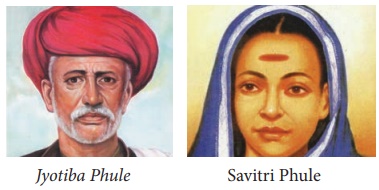Towards Modernity - Satya Shodhak Samaj (1873) | 11th History : Chapter 19 : Towards Modernity
Chapter: 11th History : Chapter 19 : Towards Modernity
Satya Shodhak Samaj (1873)
Satya Shodhak Samaj (1873)

While the movements discussed above were largely focussed on upper castes there were some exceptional movements which mobilized lower castes and articulated their perspective. The most important among them was Jyotiba Phule, who belonged to the Mali (gardener) community. Born in 1827, he received initial education in a mission school but had to discontinue it in 1833. Jyotiba Phule waged a life-long struggle against upper caste tyranny. In his quest for the truth, Phule read the Vedas, the Manu Samhita, the Puranas, and the thought of Buddha, Mahavira and the medieval Bhakti saints extensively. He also acquainted himself with Western thought, and Christian and Islamic religions. Phule judged the whole culture and tradition through the spirit of rationality and equality. While the principle of equality called for a total rejection of caste system, authoritarian family structure and subordination of women, the principle of rationality demanded the removal of superstitions and ritualism.
Phule held radical views on social, religious, political
and economic issues. He considered the caste system as an antithesis of the
principle of human equality. He sought to raise the morale of the non-Brahmins
and united them to revolt against the centuries old inequality and social
degradation. Towards this end Phule founded the Satya Shodak Samaj (Society
for Seeking Truth) in 1875. His most
important book is Gulamgiri
(Slavery).
Phule looked upon education of the masses as a
liberating and revolutionary factor.
Since women and deprived and downtrodden were the
worst sufferers in the society, Phule argued that women’s liberation was linked
with the liberation of other classes in society. Equality between classes as
also between men and women was stressed by Phule. During marriages he asked the
bridegroom to promise the right of education to his bride.
Phule also tried to translate his ideas into actual
struggles. He urged the British Government to impart compulsory primary
education to the masses through teachers drawn from the cultivating classes. He
started a school for girls in Poona in 1851 and one for depressed classes with
the assistance of his wife Savitri. He also started schools for the
"untouchables" and founded a home for widow’s children.
In his work we find the beginnings of the later day
non-Brahman movement of Maharashtra.
Pandita Ramabai (1858–1922)

Pandita Ramabai was foremost among the Indian
leaders who worked for the emancipation of women. She came from a learned
family and was a great scholar of Sanskrit and addressed many learned groups in
different parts of the country. She was given the title of “Pandita” and
“Saraswati” for her deep knowledge of Sanskrit. After the death of her parents
she and her brother travelled to different parts of the country. They went to
Calcutta in 1878. Two years later her brother also died. A little later in 1880
she married a Bengali belonging to a family of lower social status. Thus, even
at that time she was bold enough to marry a man of a different caste and
different language. After the death of her husband two years later she returned
to Poona and started the Arya Mahila Samaj with the help of leaders like Ranade
and Bhandarkar. 300 women were educated in the Samaj in 1882.
Ramabai started the Sharada Sadan (shelter for homeless)
for the destitute widows with the help of Ranade and Bhandarkar. But soon she
was accused of converting Hindu women to Christianity and hence had to shift
her activities to Khedgoan near Poona. She established a Mukti Sadan (freedom
house) there. Soon there were 2000 children and women in the house. Vocational
training was given make them self-reliant.
Sri Narayana Guru
This movement emerged in Kerala and was born out of
conflict between the depressed classes and the upper castes. It was started by Sri
Narayana Guru (1854-1928) spearheading a social movement of the Ezhavas of
Kerala, a community of toddy tappers. The Ezhavas were the single largest group
in Kerala constituting 26% of population. A great scholar in Malayalam, Tamil
and Sanskrit, Sri Narayana Guru established the Sri Narayana Guru Dharma
Paripalana (SNDP) Yogam in 1902. The SNDP Yogam took up several issues such as
(i) right of admission to public schools.
(ii) recruitment to government services.
(iii) access to roads and entry to temples; and
(iv) political representation.
The movement as a whole brought transformative
structural changes such as upward social mobility, shift in traditional
distribution of power and a federation of ‘backward classes’ into a large
conglomeration. As a response to the prohibition on Ezhavas into temples, Sri
Narayana Guru established new temples, and empowered the community to modernize
itself. Great personalities such as the poet Kumaran Asan Dr. Palpu and
Sahodaran Ayyappan emerged from the movement, and made a lasting impact in the
democratization of Kerala Society. Even though the Guru himself was not
directly involved in the movement, the Vaikom Satyagraha, organized to protest
against the ban on the entry of Ezhavas on the temple streets of Vaikom made a
deep impact on subsequent temple entry movements.
Related Topics